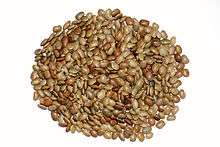Macrotyloma uniflorum
| Macrotyloma uniflorum | |
|---|---|
 | |
| Scientific classification | |
| Kingdom: | Plantae |
| (unranked): | Angiosperms |
| (unranked): | Eudicots |
| (unranked): | Rosids |
| Order: | Fabales |
| Family: | Fabaceae |
| Genus: | Macrotyloma |
| Species: | M. uniflorum |
| Binomial name | |
| Macrotyloma uniflorum (Lam.) Verdc. | |
| Varieties | |
| |
Macrotyloma uniflorum (horse gram, kulthi bean, hurali, Madras gram) is one of the lesser known beans. The whole seeds of horse gram are generally used as cattle feed. However, it is consumed as a whole seed, as sprouts, or as whole meal in India, popular especially in southern Indian states. Medical uses of these legumes have been discussed.
Horse gram and moth bean are legumes of the tropics and subtropics, grown mostly under dry-land agriculture. The chemical composition is comparable with more commonly cultivated legumes. Like other legumes, these are deficient in methionine and tryptophan, though horse gram is an excellent source of iron and molybdenum. Comparatively, horse gram seeds have higher trypsin inhibitor and hemagglutinin activities and natural phenols than most bean seeds. Natural phenols are mostly phenolic acids, namely, 3,4-dihydroxybenzoic, 4-hydroxybenzoic, vanillic, caffeic, p-coumaric, ferulic, syringic and sinapic acids.[1] Dehusking, germination, cooking, and roasting have been shown to produce beneficial effects on nutritional quality of both the legumes. Though both require prolonged cooking, a soak solution (1.5% NaHCO3 + 0.5% Na
2CO
3 + 0.75% citric acid) has been shown to reduce cooking time and improve protein quality. Moth bean is mostly consumed as dhal or sprouts.
Indian regional specifics
In Telangana and Andhra Pradesh, horse gram (ulava (singular) ulavalu (plural), ఉలవలు) is prescribed for persons suffering from jaundice or water retention, and as part of a weight-loss diet. It is considered helpful for iron deficiencies, and is considered helpful for maintaining body temperature in the winter season. Ulavacharu (horse gram soup) is popular dish in Telangana and Andhra Pradesh, it is served in most of the Telugu-speaking people's weddings and ceremonies and tastes wonderful with boiled rice.
In Kerala, horse gram, (called മുതിര (muthira) in Malayalam which almost sounds like കുതിര (kuthira), Malayalam word for horse), is used in special kinds of dishes.
In Tamil Nadu, horse gram (called கொள்ளு (kollu, in the southern districts it is called kaanam) is commonly used in Tamil dishes, including kollu chutney, kollu porial, kollu avial, kollu sambar, and kollu rasam. In traditional siddha cuisine, horse gram is considered a food with medicinal qualities.
In Maharashtra, and specifically the coastal Konkan region and Goa, horse gram (kulith) is often used to make kulith usal, pithla, and laddu.
In India, it is also known as gahat, muthira, kulath, or kulthi, ಹುರಳಿ (hurali).
It is used to make popular dishes like kulitan saaru, kulitan upkari, kulitan ghassi (coconut curry preparation), and idli-like preparation (but not fermented) called kulitan sannan.
In Karnataka cuisine, ಹುರಳಿಸಾರು (hurali saaru), ಹುರಳಿ (hurali) is a main ingredient. Hurali is also used in preparations such as usali, chutney, basaaru, and upsaaru or upnesaru (particularly in the Old Mysore Regions Mandya and Chamrajnagara Districts).
In South Canara region of Karnataka, in Tulu, it is also called kudu (ಕುಡು). In Odisha it is known by the name କୋଳଥ (Kolatha).
Gahat or kulath is a major ingredient in the food of Pahari region of northern India. In Himachal Pradesh, kulath is used to make khichdi. In Uttarakhand, it is cooked in a round iron saute pan (kadhai) to prepare ras, a favorite of most Kumaonis. In Garhwal region, another more elaborate dish is phanu which is made in a kadhai with roughly ground gahat (previously soaked overnight) boiled over several hours. Towards the end, some finely chopped greens (palak or spinach, rai, tender radish leaves, or dhania (coriander leaves) if nothing else is available) are added to complete the dish. Served with boiled rice, jhangora (a millet-like grain, used as a staple by poorer Garhwalis only a decade ago and now a prized health-food) or just roti, phanu is a wholesome and nutritious meal. is somewhat heavy to digest; it is possible to go through the whole day without feeling in the least bit hungry, after having a big phanu meal in the morning.
Medicinal uses
Scientists from the Indian Institute of Chemical Technology have found that unprocessed raw horse gram seeds not only possess antihyperglycemic properties, but also have qualities which reduce insulin resistance. The scientists made a comparative analysis between horse gram seeds and their sprouts and found that the seeds have greater beneficial effects on the health of hyperglycemic individuals. The majority of antioxidant properties are confined to the seed coat and its removal would not do any good. Raw horse gram seed is rich in polyphenols, flavonoids, and proteins, major antioxidants present in fruits and other food materials. The seed has the ability to reduce postprandial hyperglycemia by slowing down carbohydrate digestion and reducing insulin resistance by inhibiting protein-tyrosine phosphatase 1 beta enzyme.[2]
References
- ↑ Identification and quantification of phenolic acids in Macrotyloma uniflorum by reversed phase HPLC. Kawsar, S.M.A., E. Huq, N. Nahar and Y. Ozeki, Am. J. Plant Physiol., 3: 165-172, 2008, doi:10.3923/ajpp.2008.165.172
- ↑ http://www.thehindu.com/sci-tech/health/diet-and-nutrition/raw-horse-gram-good-for-diabetics/article4651090.ece
External links
- Kadam SS, Salunkhe DK (1985). "Nutritional composition, processing, and utilization of horse gram and moth bean". Crit Rev Food Sci Nutr. 22 (1): 1–26. doi:10.1080/10408398509527416. PMID 3899515.
![]() Media related to Macrotyloma uniflorum at Wikimedia Commons
Media related to Macrotyloma uniflorum at Wikimedia Commons